Stephanie A. Mann's Blog, page 246
February 13, 2014
Charles I's Painter Looks Over His Shoulder
Richard Cork discusses Anthony Van Dyck's last "Self-Portrait" in The Wall Street Journal; he finds the artist concerned about his patron and his own health:
Van Dyck appears increasingly ill-at-ease, as if his fierce concentration on the task at hand has been diverted by some unexpected intrusion. He seems startled, and I can imagine him feeling annoyed by the disturbance. His mouth might be on the point of opening. A hint of a frown can be detected curving up from the edge of his raised right eyebrow.
What is really going on here? Van Dyck's last "Self-Portrait" may well reflect his gathering alarm about the state of his adopted home. Charles I, who contributed so greatly to Van Dyck's success, had alienated a growing number of powerful forces. And Van Dyck's eminent position within the royal court must have alerted him to the danger now confronting the monarch. (Civil war would break out in 1642.) Van Dyck was sensitive enough to appreciate the problem, and his anxiety could have been exacerbated by his own illness.
Van Dyck probably sensed, when he stared at his own reflection and set it down on canvas, that his health was ominously poor. In August 1641 the Countess of Roxburghe reported in a letter that he had been ill for a long time, and soon afterward Van Dyck grew so infirm that he abandoned a major commission to paint Cardinal Richelieu's portrait in Paris. He must have felt very frustrated, and at the base of the elaborate oak frame surrounding his last "Self-Portrait" a demonic face scowls as he opens his mouth in a roar of rage. There is certainly a haunting awareness of transience in the "Self-Portrait." Even as he emphasizes the strength of his penetrating gaze, Van Dyck conveys a melancholy awareness that nothing of him will endure very long, apart from the art he creates. The white shirt that occupies such a prominent space near the center of the painting looks as turbulent as a storm-stricken sea. This boldly handled passage of paint could almost be seen as prophetic, hinting at the military tempest that was about to engulf England and destroy the king along with so many of his subjects in a catastrophic conflict.
The National Portrait Gallery in London is raising funds to purchase, preserve, and display this portrait (and keep it from being obtained by a private collector). More about that effort here.
Van Dyck appears increasingly ill-at-ease, as if his fierce concentration on the task at hand has been diverted by some unexpected intrusion. He seems startled, and I can imagine him feeling annoyed by the disturbance. His mouth might be on the point of opening. A hint of a frown can be detected curving up from the edge of his raised right eyebrow.
What is really going on here? Van Dyck's last "Self-Portrait" may well reflect his gathering alarm about the state of his adopted home. Charles I, who contributed so greatly to Van Dyck's success, had alienated a growing number of powerful forces. And Van Dyck's eminent position within the royal court must have alerted him to the danger now confronting the monarch. (Civil war would break out in 1642.) Van Dyck was sensitive enough to appreciate the problem, and his anxiety could have been exacerbated by his own illness.
Van Dyck probably sensed, when he stared at his own reflection and set it down on canvas, that his health was ominously poor. In August 1641 the Countess of Roxburghe reported in a letter that he had been ill for a long time, and soon afterward Van Dyck grew so infirm that he abandoned a major commission to paint Cardinal Richelieu's portrait in Paris. He must have felt very frustrated, and at the base of the elaborate oak frame surrounding his last "Self-Portrait" a demonic face scowls as he opens his mouth in a roar of rage. There is certainly a haunting awareness of transience in the "Self-Portrait." Even as he emphasizes the strength of his penetrating gaze, Van Dyck conveys a melancholy awareness that nothing of him will endure very long, apart from the art he creates. The white shirt that occupies such a prominent space near the center of the painting looks as turbulent as a storm-stricken sea. This boldly handled passage of paint could almost be seen as prophetic, hinting at the military tempest that was about to engulf England and destroy the king along with so many of his subjects in a catastrophic conflict.
The National Portrait Gallery in London is raising funds to purchase, preserve, and display this portrait (and keep it from being obtained by a private collector). More about that effort here.
Published on February 13, 2014 22:30
February 12, 2014
Sheppard, Davy, and Mundy from The Sixteen
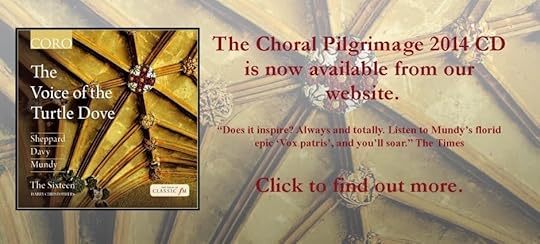
On their new CD and in their 2014 Choral Pilgrimage:
The Sixteen returns to its grass roots and revisits the golden age of Renaissance polyphony in England for the repertoire of its latest disc. In this new programme the award-winning ensemble presents a stunning selection of music by Richard Davy, John Sheppard and William Mundy.
Little is known about the life of Richard Davy. He is, however, the second most represented of all the composers in the Eton Choirbook and wrote in the beautifully florid style so characteristic of 1490s English music. The mere fact that his music survived the Reformation is nothing short of a miracle. He was a scholar of Magdalen College, Oxford, where he acted as choir master and organist and it is believed that he wrote the monumental O Domine caeli terraeque creator in the span of a single day during his time at the college.
John Sheppard's musical style contains all the grandness and idiosyncrasies of English harmonic invention, as is aptly displayed on this new recording which includes one of the gems of Tudor music - the glorious seven-part Trinity antiphons Libera nos with their ethereal combination of upper voices balanced with an even-note cantus firmus in the bass, as well as one of the most grandiose of Sheppard’s responsories, Gaude, gaude, gaude Maria, a magnificent setting of the responsory and prosa for Second Vespers for the Feast of the Purification.
William Mundy was one of the few composers whose career bridged the Reformation and allowed him to develop his style through a variety of important periods. His Votive antiphon,Vox patris caelestis, probably written for the Feast of the Assumption of the Blessed Virgin Mary in the reign of Mary Tudor, can be considered as the culmination of the great antiphon tradition with its elaborate and virtuosic vocal writing and daunting extended range.
The track listings are:
John Sheppard (c.1515-58/9)
1. Gaude, gaude, gaude Maria
William Mundy (c.1530-before 1591)
2. Adolescentulus sum ego
Richard Davy (c.1465-c.1521)
3. O Domine caeli terraeque creator
Sheppard
4. Libra nos I & II
5. In manus tuas I
Davy
6. Ah, mine heart, remember thee well
Sheppard
7. In manus tuas III
Mundy
8. Vox patris caelestis
While enduring withdrawal symptoms from the football season Sunday night, I watched the first episodes of Music and Monarchy again--with performances from Eton College, King's College, Cambridge, et al. I enjoyed again how David Starkey and his experts demonstrated the arrangements of College choirs around the huge choir book; then showed the changes made in the composition of music and the membership of the choir during the Tudor Reformation transitions, etc.
Something I did not comment on when I posted my review of Music and Monarchy is the other gradual transition Starkey demonstrates. From the Tudors to the Stuarts to the Hanoverians to the Windsors, the purpose of music at Court, Chapel Royal, and Cathedral changed. First, as Starkey showed particularly with the example of Henry V and Henry VI, the purpose was worship of God. Then, with the Restoration of Charles II and particularly the coronation of James II, the purpose was supporting the monarchy and king, which Purcell continued with the odes to Mary, for example, during the reign of William and Mary. After William curtailed music at Court, English music was revived during the Hanoverian dynasty by the German Handel--and George III supported his music and talent so much that the focus of the musical performance for the monarchy became recognition of the composer. With the Windsors, the purpose of music for the monarchy was patriotism or even nationalism: "Land of Hope and Glory", the Proms, the processional hymn by Ralph Vaughn Williams at Elizabeth II's coronation, "All People That On Earth Do Dwell", the focus was on the people and the glories of being English!
From God, to the King, to the composer, to the people.
Published on February 12, 2014 23:00
February 11, 2014
The "Gloomy Dean" and Thomas More's "Unfinished" Reformation
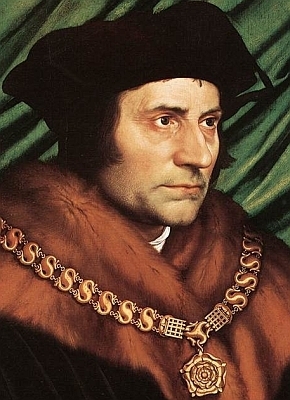 William Ralph Inge was Dean of St. Paul's Cathedral from 1911 to 1934 (thus a successor of John Colet, John Feckenham, and John Donne, among many others) and a prolific author. He was called the "Gloomy Dean" because of the rather pessimistic attitude he expressed in his Evening Standard columns. I think a more elegant epithet would have been the "Melancholy Dean" as a pun on Hamlet!
William Ralph Inge was Dean of St. Paul's Cathedral from 1911 to 1934 (thus a successor of John Colet, John Feckenham, and John Donne, among many others) and a prolific author. He was called the "Gloomy Dean" because of the rather pessimistic attitude he expressed in his Evening Standard columns. I think a more elegant epithet would have been the "Melancholy Dean" as a pun on Hamlet!According to this site, Dean Inge "was a passionate Christian Platonist known in the academy for his work on mysticism, Plotinus and a synthesis of Christianity and Platonism." Inge was definitely passionate about his opposition to the Catholic Church. As the Wikipedia article states, "He was a strong proponent of a spiritual type of religion—"that autonomous faith which rests upon experience and individual inspiration"—as opposed to one of coercive authority; he was outspoken in his criticisms of the Roman Catholic Church."
In an essay titled "Protestantism: A Problem Novel", G.K. Chesterton critiqued a pamphlet in which the Protestant Divine argued for a new Reformation, since he was not inclined to follow Lutheran or Calvinist doctrine. But first Chesterton argues the pamphlet should have been titled Catholicism since the Dean cannot really define Protestantism, but can certainly attack Catholicism:
It is only what he has to say about Catholicism that is clear, consistent and to the point. It is warmed and quickened by the human and hearty motive of hatred; and it makes everything else in the book look timid and tortuous by comparison.
Chesterton quotes Dean Inge's description of the purpose of Protestantism and comments on it: "What is the main function of Protestantism? It is essentially an attempt to check the tendency to corruption and degradation which attacks every institutional religion." So far, so good. In that case St. Charles Borromeo, for instance, was obviously a leading Protestant. St. Dominic and St. Francis, who purged the congested conventionalism of much of the monasticism around them, were obviously leading Protestants. The Jesuits who sifted legend by the learning of Bollandism, were obviously leading Protestants. But most living Protestant leaders are not leading Protestants. If degradation drags down EVERY institutional religion, it has presumably dragged down Protestant institutional religion. Protestants might possibly appear to purge Protestantism; but so did Catholics appear to purge Catholicism. Plainly this definition is perfectly useless as a DISTINCTION between Protestantism and Catholicism.
But then, Chesterton cites the strangest comment of all in the Gloomy Dean's pamphlet:
It is in this direction that Protestants may look for the beginning of what may really be a new Reformation, a resumption of the unfinished work of Sir Thomas More, Giordano Bruno and Erasmus. I'm not sure what Giordano Bruno would have really contributed to this new Reformation? Denial of the Divine Person of Our Incarnate Savior? Heliocentrism? But Chesterton really has some fun with Inge's suggestion that we need "a resumption of the unfinished work of Sir Thomas More . . .":
In short, Protestants may look forward to a Reformation modelled on the work of two Catholics and one obscure mystic, who was not a Protestant and of whose tenets they and the world know practically nothing. One hardly knows where to begin, in criticising this very new Reformation, two-thirds of which was apparently started by men of the Old Religion. We might meekly suggest that, if it be regrettable that the work of Sir Thomas More was "unfinished," some portion of the blame may perhaps attach to the movement that cut off his head. . . .
For this, it seems, is how we stand. We are not to follow Luther and Calvin. But we are to follow More and Erasmus. And that, if you please, is the true Protestantism and the promise of a second Reformation. We are to copy the views and virtues of the men who found they could remain under the Pope, and especially of one who actually died for the supremacy of the Pope.
So I have to ask, did Dean Inge realize what kind of Reformation Sir/Saint Thomas More would have led or encouraged? More would certainly have reformed abuses: he would have used Bishop/St. John Fisher as the model of a good bishop, resident and attentive; he would have held up the Carthusians and Observant Franciscans (also martyred under Henry VIII) as models of monastic and mendicant life; he would have agreed with Erasmus that Catholic piety and devotion needed to be based on the Holy Bible. Did Dean Inge realize that St. Thomas More's "unfinished work" of Reformation would have maintained Catholic teaching on the Sacraments, on the Real Presence of Holy Communion, on the role of the Papacy? St. Thomas More would not have been a strong proponent of a Reformation based on "that autonomous faith which rests upon experience and individual inspiration"--he would have looked to the legitimate authority of the Catholic Church and would have appealed to "Christendom" as he said at his trial, not to something autonomous and individual, for the inspiration of his Reformation.
Published on February 11, 2014 22:30
February 10, 2014
An Amazing Anniversary: The Resignation of Pope Benedict XVI
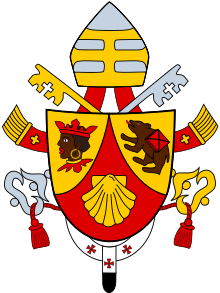 Matthew Bunson remembers February 11, 2013 in
Our Sunday Visitor
:
Matthew Bunson remembers February 11, 2013 in
Our Sunday Visitor
:Many Catholics can remember the dramatic Year of Three Popes in 1978, when Pope Paul VI died, was succeeded by the short-lived Pope John Paul I and was himself followed by Pope Blessed John Paul II. Years from now, Catholics looking back at 2013 will likely express a similar amazement at the Year of Two Popes. The one notable difference, of course, is that the sede vacante— the interregnum between pontiffs — was not to bury a deceased pope and elect his successor, but to witness the departure of one pope through resignation and the election of a new Vicar of Christ under circumstances not encountered in more than 700 years.
Pope Benedict XVI’s announcement last February that he would renounce the papacy at the end of that month sent a genuine shockwave through the Church and across the globe. His decision was not unprecedented, but it was certainly unique in the modern life of the Church. . . .
On the morning of Feb. 11, 2013, Pope Benedict informed a gathering of the cardinals in Rome and other officials of the Roman Curia that he was resigning. Cardinal Angelo Sodano, dean of the College of Cardinals, spoke for the shocked room of prelates — and ultimately for the whole Church — when he said: “Your moving message has resounded in this room like a lightning bolt in a calm sky. We’ve listened to you with a sense of shock, rather in total disbelief.”
Pope Benedict had not rushed into the decision. His health had been declining, and he had grown increasingly concerned about his ability to govern the Church with the energy needed to deal with the crises of modernity and to implement the reforms that were needed. According to the Vatican newspaper L’Osservatore Romano, Pope Benedict had reached the decision to resign after his journey to Mexico and Cuba in the spring of 2012.
I do remember the Year of Three Popes--I heard the early morning radio reports of Pope John Paul I's death and told my mother (my father was out of town on business). When I told her the Pope was dead, she said "Again?' (it was very early in the morning of course!)
I remember last year's amazing announcement too. I was all set to talk to Brian Patrick on the Son Rise Morning Show about Shrovetide, Confession, pancakes and pancake races. Then producer Matt Swaim emailed me with a change in topic: we would instead discuss Pope Benedict and the English Reformation, highlighting the September 2010 visit to Scotland and England, the establishment of the Anglican Ordinariate, and the beatification of John Henry Newman--all the ways Benedict had tried to heal the wounds of the sixteenth century. Eventually, I found a place for the article that developed after that interview--it's in the January/February issue of the St. Austin Review. (But you have to subscribe to the print edition to read it/or buy an individual copy.)
Matt Swaim described that busy morning for The Catholic Beat in Cincinnati, as he scrambled to refocus that day's programming to respond to the news:
My first call was to EWTN Rome Bureau Chief Joan Lewis, who breathlessly begged me to give her five minutes before calling her back for a live interview. Since she’s based in Rome, it worked out that she’d been awake for several hours, and was able to speak to the physical appearance of Pope Benedict in recent days. Al Kresta was also awake (even though he mans the afternoon program on the network), and was able to join in the conversation as well. At that point, I had put out dozens of emails, Twitter messages and phone calls to people like Vatican Radio’s Emer McCarthy (who did an excellent job, especially since she and everyone else at the Vatican officially had the day off), Canon Lawyer Ed Peters, who was able to comment with reasonable intelligence about what this all meant canonically, Teresa Tomeo, whose show airs after ours on EWTN, and others, piecing together things as they came to mind and potential guests responded. Special thanks goes out to Stephanie Mann, whose planned segment on English Shrovetide traditions instantly became a segment on the significance of Pope Benedict’s other major historical move- the introduction of the Anglican Ordinariate. . . .
Just a year ago today!
(Image Credit: Pope Benedict XVI's Papal Coat of Arms)
Published on February 10, 2014 22:30
February 9, 2014
Diplomacy and Division Between England and Rome
As I noted yesterday, I'll be on the Son Rise Morning Show this morning to discuss the meeting between Pope Francis and Queen Elizabeth II. This is not the Queen's first visit to the Vatican.
In 1980, Queen Elizabeth met with Pope John Paul II at the Vatican as part of a State Visit to Italy. She has also met Pope John Paul II, Pope John XIII, and Pope Pius XII at the Vatican (the latter when she was a princess) in private audiences. Pope John Paul II and Pope Benedict XVI met her during their visits to the British Isles, in 1982 and 2010, respectively.
This is not a State Visit--the Queen and the Duke are having a private luncheon with the President of Italy and then going to the Vatican to meet Pope Francis. They will meet at the Santa Marta guesthouse and not in the Apostolic Palace.
There are many pictures on the web of Queen Elizabeth's earlier visits, wearing a black dress, black closed shoes, and a black veil--but the veil or head covering is not technically required.
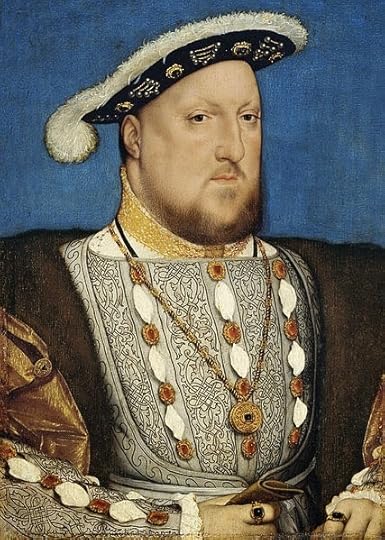
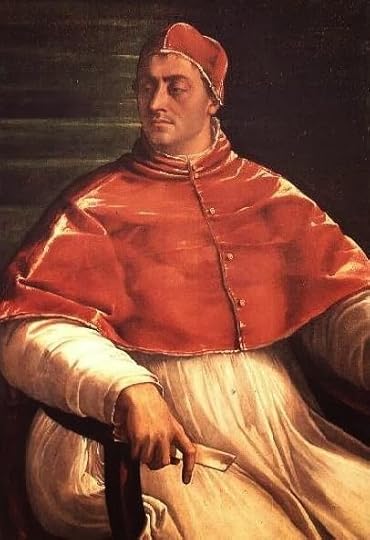 Because of the English Reformation, the history of English and Vatican diplomatic relations since the 16th century has been uneven, to say the least. Before Henry VIII"s break from Rome (Pope Clement VII), English monarchs sent ambassadors to the Papal States, as the popes of that era were secular rulers in addition to being the Bishop of Rome and the Vicar of Christ. Henry VII and Henry VIII additionally had "Cardinal Protectors" who addressed ecclesiastical matters like the appointment of bishops. England had a long history of links to Rome and those links had been strong for centuries--Saxon and Mercian kings began the tradition of giving Peter's Pence, which of course ended during Henry VIII's reign.
Because of the English Reformation, the history of English and Vatican diplomatic relations since the 16th century has been uneven, to say the least. Before Henry VIII"s break from Rome (Pope Clement VII), English monarchs sent ambassadors to the Papal States, as the popes of that era were secular rulers in addition to being the Bishop of Rome and the Vicar of Christ. Henry VII and Henry VIII additionally had "Cardinal Protectors" who addressed ecclesiastical matters like the appointment of bishops. England had a long history of links to Rome and those links had been strong for centuries--Saxon and Mercian kings began the tradition of giving Peter's Pence, which of course ended during Henry VIII's reign.Mary I and James II both re-established some diplomatic ties to the Vatican, but her death and the Glorious Revolution, respectively, ended those brief periods. Informal diplomacy between the Great Britain and the Pope took place during the French Revolution under the argument that the enemy of my enemy is my friend--in opposition to the French Revolution and the First Empire under Napoleon.
The first post-Reformation ambassador was assigned to the Vatican in 1914 at the beginning of World War I--and he was a Catholic, Henry Howard. His official title was "His Majesty's Envoy Extraordinary and Minister Plenipotentiary on a Special Mission to His Holiness the Pope". Things were stable for awhile and then in the 1930's troubles between Church and State in Malta led to another long break in higher level diplomacy at least. The Troubles in Northern Ireland also strained relations and an ambassador-level official was not appointed again until 1982, the same year that Pope John Paul II visited Scotland, England, Ireland, and Wales.
The current British ambassador to the Holy See (not the Vatican City-State) is Nigel Baker. The current ambassador from the Holy See to the Court of St. James--that is, the current Apostolic Nuncio--is Archbishop Antonio Mennini.
Published on February 09, 2014 22:00
February 8, 2014
Pope Francis and Elizabeth II to Meet
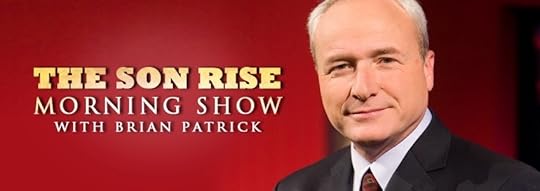
I'll be on the Son Rise Morning Show tomorrow morning at 7:45 Eastern/6:45 Central. Matt Swaim asked me to discuss this meeting, scheduled for April at the Vatican, between the Supreme Governor of the Church of England and the Pope, the Vicar of Christ, the successor of St. Peter--and the head of the Vatican City-State and the Holy See! This sounds like a rather low key visit, however, and is taking place at the Santa Marta guesthouse after the Queen has lunch with the president of Italy.
On the Son Rise Morning Show, we'll discuss the history of relations between the England and Rome, which of course, broke off during the reign of Henry VIII, and weren't firmly re-established until the reign of George V. Queen Elizabeth II has met most of the popes since Pope Pius XII (she has also met all of the U.S. Presidents since Dwight D. Eisenhower--and met Truman when she was just a princess!).
So, tune in tomorrow--you can listen live here. And I'll post some background here tomorrow, too.
Published on February 08, 2014 22:30
February 7, 2014
The Middle Ages Weren't That Dark/The Renaissance Wasn't That Bright
I'm reading G.K. Chesterton's The Thing, as I mentioned, and I think he would appreciate this article, which turns the tables on the usual paradigm re: the Middle Ages and the Renaissance. That table turning is something Chesterton does all the time.
First, the article, from The Telegraph by Dominic Selwood, "The bloody underside of the 'civilised' Renaissance":
If you looked only at the luscious paintings by Fra Angelico and Botticelli, and if you listened only to the soaring ethereal voices of Palestrina and Byrd, you would think the Renaissance was a release of centuries of pent-up creativity. You would conclude, as was once fashionable, that when the Renaissance detonated in late 1300s Italy, it sprayed hope, colour, and sensuality into a monochrome and rigid medieval world grappling with a plague that had slain a third of Europe. [In case you think Selwood is exaggerating, remember William Manchester's A World Lit Only by Fire.]
But you would be wrong for many reasons.
For starters, there was nothing monochrome about the medieval world. You need only look at the extraordinary renovations now under way at Chartres cathedral, where they are restoring the hulking grey walls and statues to their former brightly decorated brilliance, injecting a vibrancy that those who grew up with 1960s architecture can barely take in.
Equally as importantly, there was a lot the Renaissance, for all its splendour, left unchanged. It may have been a celebration of living rather than earthly preparation for an afterlife, but it did not immediately improve life for everyone. For example, as the oligarchs of the day splashed their immense wealth around, patronizing works and monuments to their eternal glory, the majority of the population remained bound to the unforgiving and harsh drudgery of subsistence level agricultural and artisanal life.
We sometimes have a slightly deluded view of the period, seeing it as the dawning of a civilised age of "high culture", with an intense new focus on art, writing, and music – quite unlike anything that had gone before.
Selwood goes on to comment on two horrible executions--dark highlights of the Renaissance--that of Girolamo Savonarola (mentioned in the context of the anniversary of his "Bonfire of the Vanities" on February 7, 1497) and the other of Mary, Queen of Scots on February 8, 1587.
 As he describes Savonarola's end:
As he describes Savonarola's end:
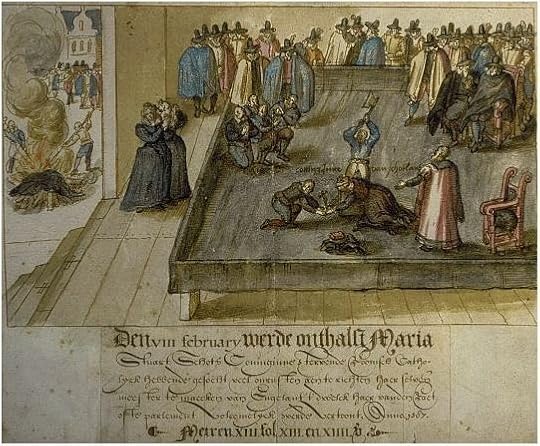 In the time-honoured fashion, a kangaroo court was duly convened. Savonarola and his two most loyal fellow Dominican friars were first tried by civil judges, then by Church commissioners, although neither result was ever in doubt. As one of the judges noted before the trial, “We shall have a fine bonfire tonight.”
In the time-honoured fashion, a kangaroo court was duly convened. Savonarola and his two most loyal fellow Dominican friars were first tried by civil judges, then by Church commissioners, although neither result was ever in doubt. As one of the judges noted before the trial, “We shall have a fine bonfire tonight.”
The three priests were quickly convicted, sentenced, stripped, walked over spikes, then hanged and burned in the central Piazza della Signoria. The once-adoring Florentines danced around the pyre, and the city’s children threw stones at the burning corpses.
And then he describes the execution of Mary, Queen of Scots:
It was a tawdry affair. Mary was not permitted a priest of her religion, so said her own prayers quietly in Latin. She remained poised and calm. Among her last words, she forgave her executioner with all her heart because “now, I hope, you shall make an end of all my troubles”.
The first blow with the axe missed her neck and took off part of her head. The next was not hard enough, But the third finally severed her neck. Her dog, bloodied by the gore, lay between her head and shoulders, refusing to be parted from her. According to an eye witness, “her lips stirred up and down a quarter of an hour after her head was cut off”.
As a final insult, her request to be buried in Rheims was overruled, and she was given a Protestant funeral in Peterborough.
Read the rest of the article here (which also ties in the forthcoming visit of Queen Elizabeth and Pope Francis at the Vatican).
Now, for Chesterton's turning the tables: in an article titled "The Early Bird in History", Chesterton notes "there's a common and current charge against the Catholic Church, that she is, as the phrase goes, always behind the times."
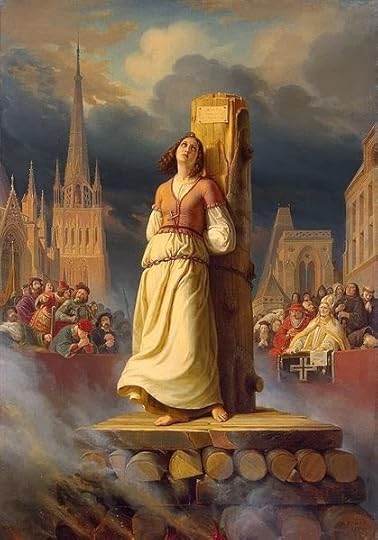 Not that there's anything wrong with that, he says, when you consider the times, but then he notes at least one instance in which the Catholic Church was far ahead of anyone else and in ways that no other institution had caught up with (in 1929, at least). He examines the rehabilitation of St. Joan of Arc. Chesterton notes that her canonization may have taken centuries, but her rehabilitation did not. The Church investigated, acknowledged the injustice, and cleared her name during the lifetime of her family-- of her mother.
Not that there's anything wrong with that, he says, when you consider the times, but then he notes at least one instance in which the Catholic Church was far ahead of anyone else and in ways that no other institution had caught up with (in 1929, at least). He examines the rehabilitation of St. Joan of Arc. Chesterton notes that her canonization may have taken centuries, but her rehabilitation did not. The Church investigated, acknowledged the injustice, and cleared her name during the lifetime of her family-- of her mother.
Then Chesterton considers some other cases: Did Edward III repent of the brutal execution of William Wallace by Edward I? Did Elizabeth I rehabilitate Sir Thomas More, acknowledge the error of his trial, conviction, and execution as a traitor? Of course they did not.
He acknowledges that in the 19th century the English did "make a romance about Wallace" and finally start thinking of St. Joan of Arc with more favor and recognition of their own tawdry role. (Shakespeare's depiction of Joan, he notes, features "insular insults".)
Chesterton has two more historical parallels: have the English honored Daniel O'Connell, the catalyst of Catholic Emancipation within one hundred years of that great milestone (1829-1929)? Have they accepted Robert Emmet of Ireland as well as they've accepted George Washington of the United States of America? No--in 1929, they had not. Thus, Chesterton demonstrates that the Catholic Church was not so far behind the times as "people" say, and in fact, the secular world is really far behind in the process of acknowledging past injustices.
You've have to read the rest of the essay, particularly as Chesterton cites how far ahead of their times the Jesuits were!
Next week, I might have to share what Chesterton writes about Dean Inge and Thomas More--it's funny, true, and surprising at the same time.
First, the article, from The Telegraph by Dominic Selwood, "The bloody underside of the 'civilised' Renaissance":
If you looked only at the luscious paintings by Fra Angelico and Botticelli, and if you listened only to the soaring ethereal voices of Palestrina and Byrd, you would think the Renaissance was a release of centuries of pent-up creativity. You would conclude, as was once fashionable, that when the Renaissance detonated in late 1300s Italy, it sprayed hope, colour, and sensuality into a monochrome and rigid medieval world grappling with a plague that had slain a third of Europe. [In case you think Selwood is exaggerating, remember William Manchester's A World Lit Only by Fire.]
But you would be wrong for many reasons.
For starters, there was nothing monochrome about the medieval world. You need only look at the extraordinary renovations now under way at Chartres cathedral, where they are restoring the hulking grey walls and statues to their former brightly decorated brilliance, injecting a vibrancy that those who grew up with 1960s architecture can barely take in.
Equally as importantly, there was a lot the Renaissance, for all its splendour, left unchanged. It may have been a celebration of living rather than earthly preparation for an afterlife, but it did not immediately improve life for everyone. For example, as the oligarchs of the day splashed their immense wealth around, patronizing works and monuments to their eternal glory, the majority of the population remained bound to the unforgiving and harsh drudgery of subsistence level agricultural and artisanal life.
We sometimes have a slightly deluded view of the period, seeing it as the dawning of a civilised age of "high culture", with an intense new focus on art, writing, and music – quite unlike anything that had gone before.
Selwood goes on to comment on two horrible executions--dark highlights of the Renaissance--that of Girolamo Savonarola (mentioned in the context of the anniversary of his "Bonfire of the Vanities" on February 7, 1497) and the other of Mary, Queen of Scots on February 8, 1587.
 As he describes Savonarola's end:
As he describes Savonarola's end: In the time-honoured fashion, a kangaroo court was duly convened. Savonarola and his two most loyal fellow Dominican friars were first tried by civil judges, then by Church commissioners, although neither result was ever in doubt. As one of the judges noted before the trial, “We shall have a fine bonfire tonight.”
In the time-honoured fashion, a kangaroo court was duly convened. Savonarola and his two most loyal fellow Dominican friars were first tried by civil judges, then by Church commissioners, although neither result was ever in doubt. As one of the judges noted before the trial, “We shall have a fine bonfire tonight.”The three priests were quickly convicted, sentenced, stripped, walked over spikes, then hanged and burned in the central Piazza della Signoria. The once-adoring Florentines danced around the pyre, and the city’s children threw stones at the burning corpses.
And then he describes the execution of Mary, Queen of Scots:
It was a tawdry affair. Mary was not permitted a priest of her religion, so said her own prayers quietly in Latin. She remained poised and calm. Among her last words, she forgave her executioner with all her heart because “now, I hope, you shall make an end of all my troubles”.
The first blow with the axe missed her neck and took off part of her head. The next was not hard enough, But the third finally severed her neck. Her dog, bloodied by the gore, lay between her head and shoulders, refusing to be parted from her. According to an eye witness, “her lips stirred up and down a quarter of an hour after her head was cut off”.
As a final insult, her request to be buried in Rheims was overruled, and she was given a Protestant funeral in Peterborough.
Read the rest of the article here (which also ties in the forthcoming visit of Queen Elizabeth and Pope Francis at the Vatican).
Now, for Chesterton's turning the tables: in an article titled "The Early Bird in History", Chesterton notes "there's a common and current charge against the Catholic Church, that she is, as the phrase goes, always behind the times."
 Not that there's anything wrong with that, he says, when you consider the times, but then he notes at least one instance in which the Catholic Church was far ahead of anyone else and in ways that no other institution had caught up with (in 1929, at least). He examines the rehabilitation of St. Joan of Arc. Chesterton notes that her canonization may have taken centuries, but her rehabilitation did not. The Church investigated, acknowledged the injustice, and cleared her name during the lifetime of her family-- of her mother.
Not that there's anything wrong with that, he says, when you consider the times, but then he notes at least one instance in which the Catholic Church was far ahead of anyone else and in ways that no other institution had caught up with (in 1929, at least). He examines the rehabilitation of St. Joan of Arc. Chesterton notes that her canonization may have taken centuries, but her rehabilitation did not. The Church investigated, acknowledged the injustice, and cleared her name during the lifetime of her family-- of her mother. Then Chesterton considers some other cases: Did Edward III repent of the brutal execution of William Wallace by Edward I? Did Elizabeth I rehabilitate Sir Thomas More, acknowledge the error of his trial, conviction, and execution as a traitor? Of course they did not.
He acknowledges that in the 19th century the English did "make a romance about Wallace" and finally start thinking of St. Joan of Arc with more favor and recognition of their own tawdry role. (Shakespeare's depiction of Joan, he notes, features "insular insults".)
Chesterton has two more historical parallels: have the English honored Daniel O'Connell, the catalyst of Catholic Emancipation within one hundred years of that great milestone (1829-1929)? Have they accepted Robert Emmet of Ireland as well as they've accepted George Washington of the United States of America? No--in 1929, they had not. Thus, Chesterton demonstrates that the Catholic Church was not so far behind the times as "people" say, and in fact, the secular world is really far behind in the process of acknowledging past injustices.
You've have to read the rest of the essay, particularly as Chesterton cites how far ahead of their times the Jesuits were!
Next week, I might have to share what Chesterton writes about Dean Inge and Thomas More--it's funny, true, and surprising at the same time.
Published on February 07, 2014 22:30
February 6, 2014
2014 Newman Lecture in Wichita, Kansas
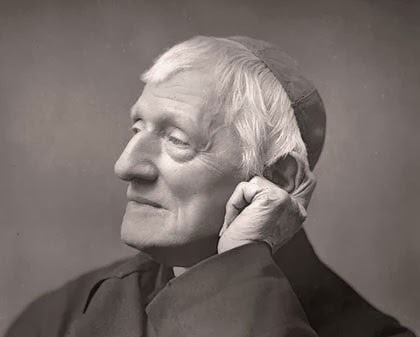 During the week around Blessed John Henry Newman's birthday on February 21, Newman University hosts its annual Cardinal Newman Week, with a presentation, alumni and development events, Mass, and High Tea. The speaker this year is Professor Kevin Godfrey from Alvernia University, a Franciscan university in Reading, Pennsylvania.
During the week around Blessed John Henry Newman's birthday on February 21, Newman University hosts its annual Cardinal Newman Week, with a presentation, alumni and development events, Mass, and High Tea. The speaker this year is Professor Kevin Godfrey from Alvernia University, a Franciscan university in Reading, Pennsylvania.According to Newman University's website:
Alvernia University theology professor Kevin Godfrey will be the featured presenter at the Gerber Institute-sponsored Cardinal Newman Lecture on Tuesday, February 18 at 4 pm in the Dugan-Gorges Conference Center on the campus of Newman University. The lecture, part of Newman University’s annual celebration of Cardinal Newman Week in honor of its namesake, is free and open to the public.
Professor Godfrey’s lecture is titled “John Henry Newman on the Mind’s Ability to Know God: The Knowledge-Generating Interplay of Imagination, Conscience and Prayer.”
Abstract: At age fifteen, John Henry Newman (1801-1890) became convinced that it is possible for the human mind to know God and to do so with the ultimate conviction of certitude. From that youthful insight and for the rest of his life Newman struggled to understand and express the deeper epistemological significance of that life-altering, adolescent experience. His understanding of how the mind works to know God is one of the compelling topics that he thought about endlessly. This presentation will introduce Newman’s ideas about knowing God. It will also share reflections about teaching and learning based on Newman’s insights about knowing God.
Biography: Dr. Kevin Godfrey has published articles and delivered scholarly papers at national and international conferences on topics in Historical Theology and Christian Spirituality. His main areas of interest for research are the Franciscan Tradition and the theology of John Henry Cardinal Newman. He has served as convener and moderator of the Thought of John Henry Newman Group of the Catholic Theological Society of America for the past seven years.
Published on February 06, 2014 22:30
February 5, 2014
St. Gilbert of Sempringham
The Clerk of Oxford
posted on St. Gilbert of Sempringham on Tuesday, February 4, his feast day. St. Gilbert started the only distinctively English monastic order, which of course was destroyed by Henry VIII:
Gilbert of Sempringham, who died on 4 February 1189, is notable as the founder of the Gilbertine order, and the only Englishman to have founded a religious order in the Middle Ages. I wrote about him once before here , but today I thought I'd post some extracts from the account of his life which was written, shortly after his death, by a member of the community at Sempringham. All the quotations below are taken from The Book of St Gilbert, ed. Raymonde Foreville and Gillian Keir (Oxford: Clarendon Press, 1987), which contains the Life of Gilbert and the documents relating to his canonisation.
The Gilbertine account of his life begins:
The glory of righteousness arises and lights every man who comes into this world and wishes him to come to knowledge of His name; at its setting it has cast rays of new brilliance upon the western lands of the western world. When its radiance had been cast into our midst from on high, there shone in the darkness of our night like a heavenly star brought among us a man of exemplary life called Gilbert. Chosen to be God’s servant in the land of England, he was born in a place called Sempringham of a distinguished family (something that usually and properly acts as an encouragement to virtue); but by the special nature of his life this man overcame both the world and his worldly origin. His father was called Jocelin; he was a worthy knight as well as a virtuous and wealthy man: a Norman, who owned many properties scattered throughout Lincolnshire. But his mother was English by birth, of parents who were faithful folk but came from an inferior rank.
Read the rest here.
Gilbert of Sempringham, who died on 4 February 1189, is notable as the founder of the Gilbertine order, and the only Englishman to have founded a religious order in the Middle Ages. I wrote about him once before here , but today I thought I'd post some extracts from the account of his life which was written, shortly after his death, by a member of the community at Sempringham. All the quotations below are taken from The Book of St Gilbert, ed. Raymonde Foreville and Gillian Keir (Oxford: Clarendon Press, 1987), which contains the Life of Gilbert and the documents relating to his canonisation.
The Gilbertine account of his life begins:
The glory of righteousness arises and lights every man who comes into this world and wishes him to come to knowledge of His name; at its setting it has cast rays of new brilliance upon the western lands of the western world. When its radiance had been cast into our midst from on high, there shone in the darkness of our night like a heavenly star brought among us a man of exemplary life called Gilbert. Chosen to be God’s servant in the land of England, he was born in a place called Sempringham of a distinguished family (something that usually and properly acts as an encouragement to virtue); but by the special nature of his life this man overcame both the world and his worldly origin. His father was called Jocelin; he was a worthy knight as well as a virtuous and wealthy man: a Norman, who owned many properties scattered throughout Lincolnshire. But his mother was English by birth, of parents who were faithful folk but came from an inferior rank.
Read the rest here.
Published on February 05, 2014 22:30
February 4, 2014
Next for Our GKC Reading Group: The Thing
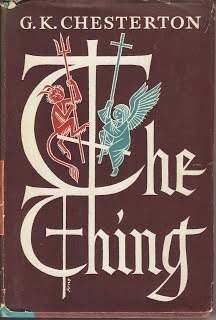 In a couple of weeks our Wichita branch of the American Chesterton Society will start our reading of G.K. Chesterton's The Thing: Why I am a Catholic. We are reading it from the Ignatius Press edition of the Collected Works: Volume III.
In a couple of weeks our Wichita branch of the American Chesterton Society will start our reading of G.K. Chesterton's The Thing: Why I am a Catholic. We are reading it from the Ignatius Press edition of the Collected Works: Volume III. It seems to me that this Chesterton work might be excellent reading for the New Evangelization, which both Blessed Pope John Paul II and Emeritus Pope Benedict have proclaimed. As Dale Ahlquist notes in his Chesterton 101 lesson for this book:
The essays in this collection were originally written for Catholic publications and are somewhat different from his other journalism because here Chesterton is writing for a specifically Catholic audience. And yet his vigorous defense of the Catholic faith seems to invite all comers. But as for addressing Catholics, there is one passage that is strikingly relevant to modern Catholics who seem intent on “reforming” things in the Church, whether it be the liturgy, the moral teachings, or the fundamental doctrines of the faith: “In the matter of reforming things, as distinct from deforming them,” says Chesterton, there are two kinds of reformers. “Let us say, for the sake of simplicity, a fence or gate erected across a road. The more modern type of reformer goes gaily up to it and says, ‘I don’t see the use of this; let us clear it away.’ To which the more intelligent type of reformer will do well to answer: ‘If you don’t see the use of it, I certainly won’t let you clear it away. Go away and think. Then, when you can come back and tell me that you do see the use of it, I may allow you to destroy it.’”
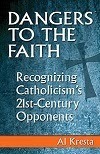 I watched Raymond Arroyo interview Al Kresta about his new book, Dangers to the Faith: Recognizing Catholicism’s 21st Century Opponents on EWTN's The World Over. Arroyo quoted Kresta from the book saying that Catholics, including the laity, in the 21st Century still aren't prepared to defend the Faith, still aren't prepared to account for our joy in Jesus Christ and His Church. Even after the great teaching pontificates of Blessed John Paul II and Pope Emeritus Benedict XVI, as Kresta said, the hay is still in the lofts of the barns and hasn't reached the horses below. But so many lay evangelists have labored to get their messages out--the entire "Theology of the Body" effort for example. George Weigel has written and spoken about Blessed John Paul II in books, articles, interviews, and speeches. Father Charles Connor presented a season of exploring "The Thought of Pope Benedict XVI" on EWTN. Ignatius Press has published dozens of Pope Benedict/Joseph Ratzinger's books before and during his papacy. I don't think it's for lack of effort on the part of teachers. Many of them have been in the loft, preparing the hay for our consumption.
I watched Raymond Arroyo interview Al Kresta about his new book, Dangers to the Faith: Recognizing Catholicism’s 21st Century Opponents on EWTN's The World Over. Arroyo quoted Kresta from the book saying that Catholics, including the laity, in the 21st Century still aren't prepared to defend the Faith, still aren't prepared to account for our joy in Jesus Christ and His Church. Even after the great teaching pontificates of Blessed John Paul II and Pope Emeritus Benedict XVI, as Kresta said, the hay is still in the lofts of the barns and hasn't reached the horses below. But so many lay evangelists have labored to get their messages out--the entire "Theology of the Body" effort for example. George Weigel has written and spoken about Blessed John Paul II in books, articles, interviews, and speeches. Father Charles Connor presented a season of exploring "The Thought of Pope Benedict XVI" on EWTN. Ignatius Press has published dozens of Pope Benedict/Joseph Ratzinger's books before and during his papacy. I don't think it's for lack of effort on the part of teachers. Many of them have been in the loft, preparing the hay for our consumption.Perhaps it's us, the students--switching metaphors from the farm to the classroom--who aren't attentive and don't take the time to listen and learn. (We have met the enemy--the danger to the Faith--and he is us!) Or to quote G.K. Chesterton's response to the question "What's wrong with the world?"--"I am." "What's wrong with the Church?" "I am."
So, if you are in Wichita, Kansas on February 21 and want to read Chesterton on Catholicism, you're welcome to come to Eighth Day Books (2838 East Douglas) at 6:30 p.m. We'll enjoy some pre-Lenten snacks and discuss the first ten essays in The Thing. Eighth Day Books should have Volume III of Chesterton's Collected Works in stock. Warren, the proprietor, has C. S. Lewis, G.K. Chesterton, Dorothy L. Sayers, George MacDonald, Charles Williams, et al, in a special section on the first floor.
As a sample, here's an excerpt from the essay titled "Why I am a Catholic," in which Chesterton discusses the Dissolution of the Monasteries:
It Is perfectly true that we can find real wrongs, provoking rebellion, in the Roman Church just before the Reformation. What we cannot find is one of those real wrongs that the Reformation reformed. For instance, it was an abominable abuse that the corruption of the monasteries sometimes permitted a rich noble to play the patron and even play at being the Abbot, or draw on the revenues supposed to belong to a brotherhood of poverty and charity. But all that the Reformation did was to allow the same rich noble to take over ALL the revenue, to seize the whole house and turn it into a palace or a pig-sty, and utterly stamp out the last legend of the poor brotherhood.
Published on February 04, 2014 22:30



